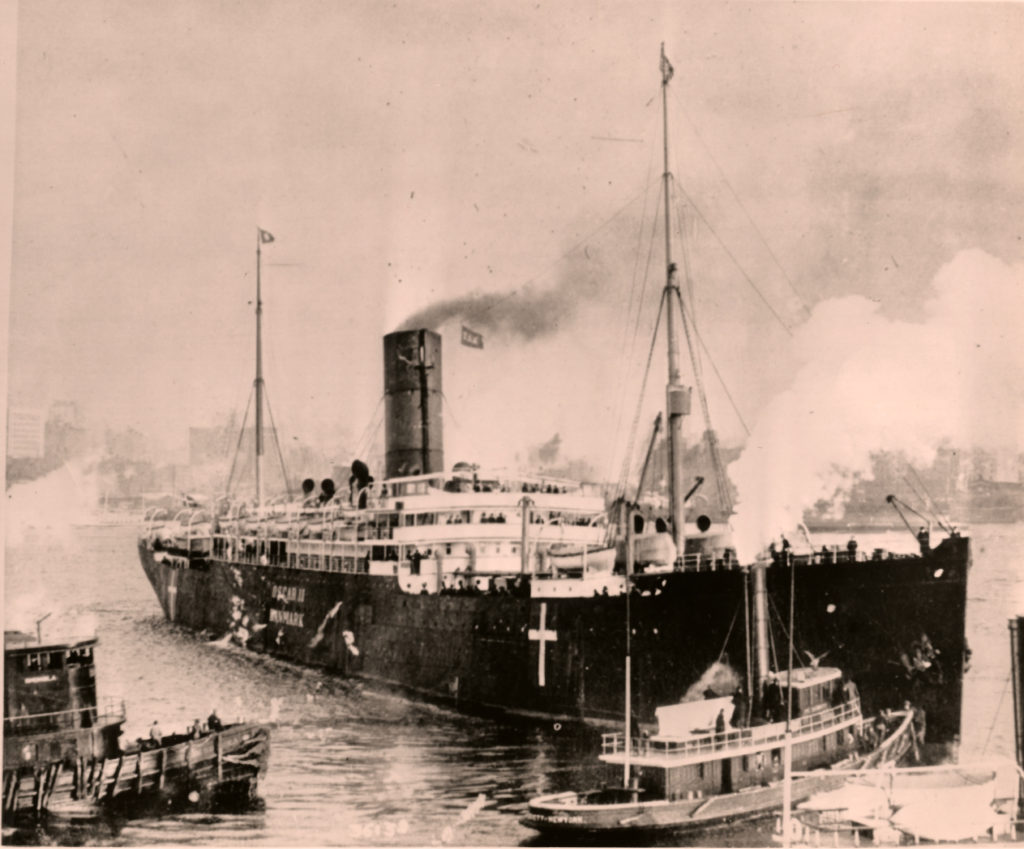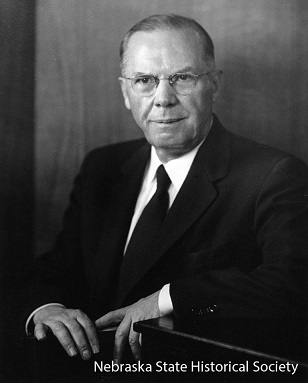We’re pursuing a nautical theme with this blog. Read our earlier post about the Titanic’s Nebraska connections here. We love it when readers help us deepen our understanding of Nebraska history. Here reader Dr. Frank Edler of Lincoln, NE adds to a previously published Timeline column about the 1915 Henry Ford Peace Expedition
 The ship Oscar II became known as Henry Ford’s “Peace Ship” in 1915
The ship Oscar II became known as Henry Ford’s “Peace Ship” in 1915
In November of 1915 four Nebraskans were invited to take part in what became known as the Henry Ford peace expedition which lasted from December 4, 1915 to the end of January, 1916. The following are the four Nebraskans who went on the trip: Arthur L. Weatherly, minister of All Souls Unitarian Church in Lincoln and secretary of the Nebraska Peace Society; Christian Abraham Sorensen, a University of Nebraska law student and assistant secretary of the Nebraska Peace Society; Walter A. Hixenbaugh, a University of Nebraska student and friend of Sorensen; and Will F. Noble, a University of Nebraska student who was invited to participate by Samuel Avery, Chancellor of the University of Nebraska.
Weatherly was invited as a delegate because of his position in the Nebraska Peace Society which was the state branch of the American Peace Society; he also was active in the Fourth American Peace Congress in St. Louis in 1913. Sorensen and Hixenbaugh were invited by Louis P. Lochner, who was Ford’s secretary on the peace expedition and notably Jane Addams’s secretary earlier at the International Congress of Women at The Hague. Both Sorensen and Hixenbaugh were active in the World Polity Club at the University of Nebraska which was established in February of 1915, and both attended the Cornell University Summer School of International Polity in June of 1915 modeled on Norman Angell’s university seminars in Great Britain.
The decision by Henry Ford in November of 1915 to reserve most of the cabins on two Scandinavian American steamships (the Oscar II and the Frederick VIII) for students, peace delegates, and journalists in order to sail to the neutral counties of Europe in an attempt to end the war makes sense only if we understand what happened earlier at the International Congress of Women.
This congress that met at The Hague at end of April 1915 laid the groundwork for a plan to organize a conference of neutral European nations to engage the warring nations in a process of mediation to end the war. Indeed at the urging of Hungarian suffragist and peace activist Rosika Schwimmer, the congress decided to appoint a number of their own members to deliver their call for mediation by hand to the heads of state of the belligerent nations. The problem was that by the end of the summer of 1915, the women had no funding to carry their project any further in terms of actually establishing a mediation conference for neutral nations. Over the late summer and early fall of 1915, Ford and his wife Clara had become increasingly concerned about the war and how to end it. When Rebecca Shelly, a young feisty pacifist, managed to get Ford to sit down for an interview with Rosika Schwimmer, a Hungarian suffragist and anti-war activist, and Louis Lochner, who was Jana Addams’ secretary at the International Congress of Women, Ford decided by November to back the idea of the neutral conference plan proposed by the International Congress of Women and to finance all the costs involved for establishing such a conference.
Some popular accounts miss this point and tend to focus on the peace expedition as a publicity stunt. For example, the Wikipedia entry under the heading “Peace Ship” claims that “He [Ford] hoped to create enough publicity to prompt the belligerent nations to convene a peace conference and mediate an end to the war.” Of course, Ford wanted the publicity to help his peace effort, but he knew full well that publicity alone would not prompt the belligerent nations to convene a peace conference. The real work was the establishment of a mediation conference among neutral nations to begin engaging the belligerent nations in a process of dialogue. To the credit of the peace expedition, this conference with members from the neutral nations of Norway, Holland, Sweden, Denmark, and the United States was indeed established. As Jane Addams remarked in her book Peace and Bread in Time of War, “Such a conference sitting continuously would take up one possibility after another for beginning peace negotiations.” [Jane Addams, Peace and Bread in Time of War with a new introductory essay by John Dewy (New York and Morningside Heights: King’s Crown Press, 1945), 30.]
The problem was timing. When one side feels like it’s winning, it probably will not want to mediate and vice versa. The trick was to find a time when both sides felt such a sense of desperation that they were at the end of their rope and might agree to begin mediation. A fair number of people who were invited did not go for various reasons. For example, Jane Addams wanted to go but came down with a kidney infection and was taken to a hospital. Emily Greene Balch declined because she felt she could not leave her classes at Wellesley College again as she had done seven months earlier to attend the International Congress of Women (Kraft, Peace Ship, 83, 90). William Jennings Bryan wanted to go, but he felt he was of greater use at home fighting the preparedness battle against Theodore Roosevelt. The Ford peace expedition was the last unified effort undertaken by Americans independent of the government to bring the Great War to an end prior to America’s declaration of war in April of 1917. Concerned that the United States was not making enough of an effort to end the war, Ford went to the White House to discuss the peace mission with President Wilson and even invited a shocked president to go along with him, but as with so many other requests asking him to lead the neutral nations in an attempt to mediate, Wilson dithered and found excuses for not participating in any official capacity. His usual reason was that if he committed himself to this plan, he wouldn’t be able to change to another one if a better plan were proposed (Kraft, The Peace Ship, 66). Wilson did not officially support Ford’s peace mission nor did he support the establishment of a neutral conference [“…Wilson reaffirmed his disinclination to have anything to do with a multinational conference whose decisions he could not control, nor would he officially sanction their enterprise” (Kraft, Peace Ship, 66)]. The remarkable thing about the expedition, ridiculed widely by the press, is that it achieved its purpose. Unfortunately, it received a minimal amount of press after the main group of delegates had returned to the United States at the end of January of 1916. Those who remained in Europe and did the hard work of establishing the mediation conference received little public attention. Even before they set off to Europe, Ford blurted out at the first press conference on November 24 that he would have the boys home from the trenches by Christmas. This, of course, was an absurd task to achieve. The crossing alone would take two weeks including the search of the ship by the British Navy. Theodore Roosevelt condemned it as a “ridiculous and mischievous jitney peace junket!” (“Roosevelt Urges Unity In Defense,” The New York Times, Dec. 6, 1915, p. 3). Nevertheless, it was one of those endeavors that inspires audacity by its boldness.
 C.A. Sorensen. Sorensen later became Nebraska’s attorney general. NSHS RG2411-52229
C.A. Sorensen. Sorensen later became Nebraska’s attorney general. NSHS RG2411-52229
Although none of the Nebraskans stayed in Europe to be part of the actual neutral conference committee, Weatherly and Sorensen, both absolute pacifists, were energized as well as disappointed by the trip. They were energized by what they were able to accomplish and by the reception they received in the neutral countries despite the fact that the United States was a supplier of munitions and credit to the Allies. They were disappointed by President Wilson’s call for a buildup of military and naval forces shortly after the Oscar II left for Norway and by Ford’s return to the United States due to illness after they reached Norway. They also discovered when they returned home by early February, 1916, that very few Americans knew about the details of the trip and the attempt to establish a conference composed of delegates from neutral nations. —- Dr. Frank Edler, professor of philosophy at Metro Community College in Omaha Sources/Further Reading: Kraft, Barbara S. Peace Ship: Henry Ford’s Pacifist Adventure in the First World War. New York: MacMillan, 1979. Print. “Peace Ship.” Wikipedia. 28 Dec. 2015. Last accessed 14 April 2016. Web. Sorensen, Juliet. “Plains Crusader: C. A. Sorensen’s Assault on Organized Crime and the Political Machine in Omaha.” Nebraska History. Fall 2015



